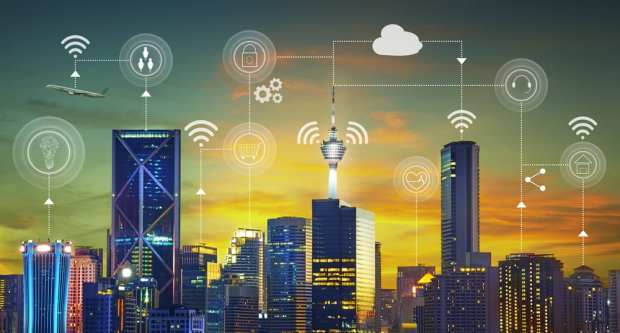Mastercard: Online Platforms – And Data – Help Cities Tackle Urban Challenges

Bright lights, big (and small) cities and Big Data.
In the drive to modernize, scale and handle burgeoning populations, cities are harnessing the power of data collection and analytics to improve infrastructure and services. As Mastercard Executive Vice President of Enterprise Partnerships and Head of Global Cities Miguel Gamiño told Karen Webster, it’s an endeavor that demands a long-term view and collaboration.
The conversation came against the backdrop of a series of announcements in 2020, one of which saw travel technology firm Amadeus join Mastercard’s City Possible network. This came weeks after a January announcement that Thailand’s Digital Economy Promotion Agency (depa) had struck an agreement to bring 27 Thai candidate smart cities into the program.
The network, launched in 2018, aims to bring various stakeholders together — spanning governments, non-governmental organizations (NGOs), academics, the private sector and others — to share insights and solutions that can be harnessed to make cities safer, more self-sustainable and inclusive.
Gamiño noted that the initial Mastercard debut of the program saw 16 cities and a few partners join. Since then, he said, “what has stayed constant has been the approach and the philosophy. Everything else seems to have changed (in a very positive direction), and it has grown substantially in terms of the number of cities and partners.”
The ‘Smart’ Definition
To get a sense of just what a “smart” city is, or should strive to be, Gamiño cautioned against using the term as a destination.
“It’s important to be clear that it’s not a destination,” he told Webster. “The term ‘smart city’ would suggest that at one day, at some point, you become ‘smart’ — that you check the boxes and get the smart city ‘seal of approval,’ and it’s all done.”
Nothing could be further from the truth, he explained, noting that the move toward modernization is a fluid one that is all about the journey and the process — and cities have been getting smarter and more livable across decades and centuries. By way of illustration, he said, several years ago, water systems were the technology of their day, and one would be hard-pressed to say their deployment didn’t make cities much cleaner and better places to live.
At a high level, he added, cities large and small must become more resilient, more inclusive, as well as offer prosperity and opportunity across all demographic lines. The need to leverage tools and intelligence to bolster the quality of life is a pressing one, according to Gamiño.
“What we are encountering right now is urbanization at scale,” he told Webster. “We already live in a world where more people live in urban centers than don’t — and that that number is growing rapidly.”
He cited statistics estimating that about 6 million people move to cities each month, a migration akin to the population of Singapore.
Data, Yes, But Insights, Too
The Internet of Things (IoT) and connectivity are, of course, taking root. Along with that connectivity comes data.
It’s been said time and again that data is the new oil. Here’s another label that he noted should be stood on its head a bit, at least when it comes to addressing pressing urban challenges.
“People talk about data a lot, but data for most people is a conceptual raw material,” he told Webster. “The idea that data is the new ‘oil’ — well, I don’t know about you, but if you handed me a barrel of crude, I’m not sure I could do much with it, … but I [could] surely benefit from the refinement of it.”
Thus, insight is key, mined from that data — giving Mastercard, the more than 40 cities currently in the program and others insight into the impact and efficacy of various solutions and programs. Insights give roadmaps toward solutions that can address and improve, say, the depa “seven dimensions” that champion mobility, energy efficiency and the environment, among others.
Across the City Possible effort, said Gamiño, “most of these cities are mostly trying to solve the same things. There are tons of loads of local nuance.”
While a copy-and-paste approach cannot be embraced, the public and private partnerships accelerate improvements through shared knowledge.
“Understanding what other cities have already done, things you can use [or] things you can avoid, to help you also narrow down where to begin and where you should aim — I call that the superpower of collaboration,” he told Webster.
In one example of that collaboration, Gamiño pointed to the entrance of Amadeus into the network. Many cities derive a significant portion of their economies from travel — tourism, yes, but also visits from businesses. Mobility is increasingly an issue for urban settings, he said, and Amadeus will bring its own technologies and insights to the City Possible ecosystem, as governments examine their city-wide transportation infrastructure. He added that other members, such as AT&T Wireless and Willis Towers Watson, will bring their own contributions and expertise to the community.
As for Mastercard: “We are trying to be a network of networks and an organizer of thought leadership. We’re incubating a new paradigm.”
Those collaborative efforts are fostered in part through City Insights, in which community leaders better use analytics with the purpose of understanding the community. As of November of last year, City Insights was being tested in Dublin, London and Helsinki.
Through shared platforms, “cities have [a] better appreciation for their commonalities, interest and the power of sharing solutions,” said Gamiño. “If they don’t collaborate, they may never be able to catch up with the pace of changing demand.”
